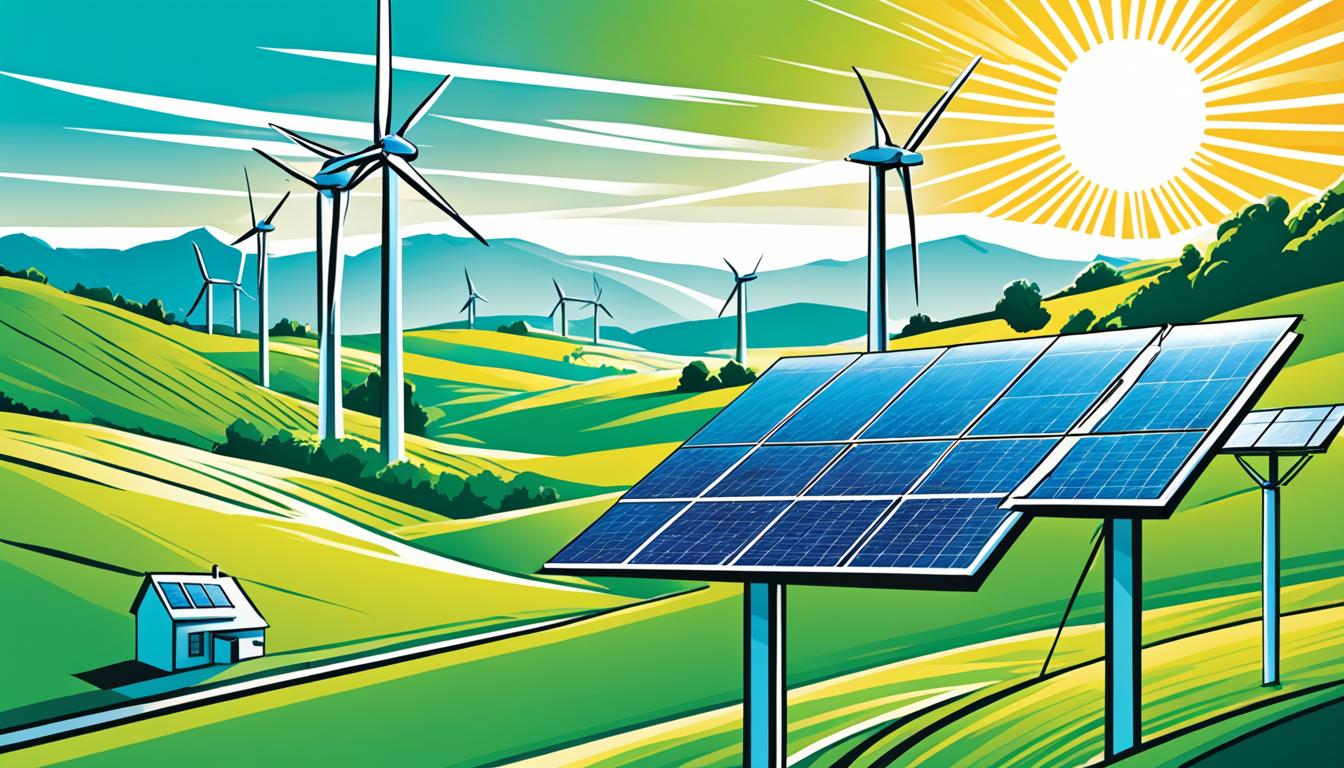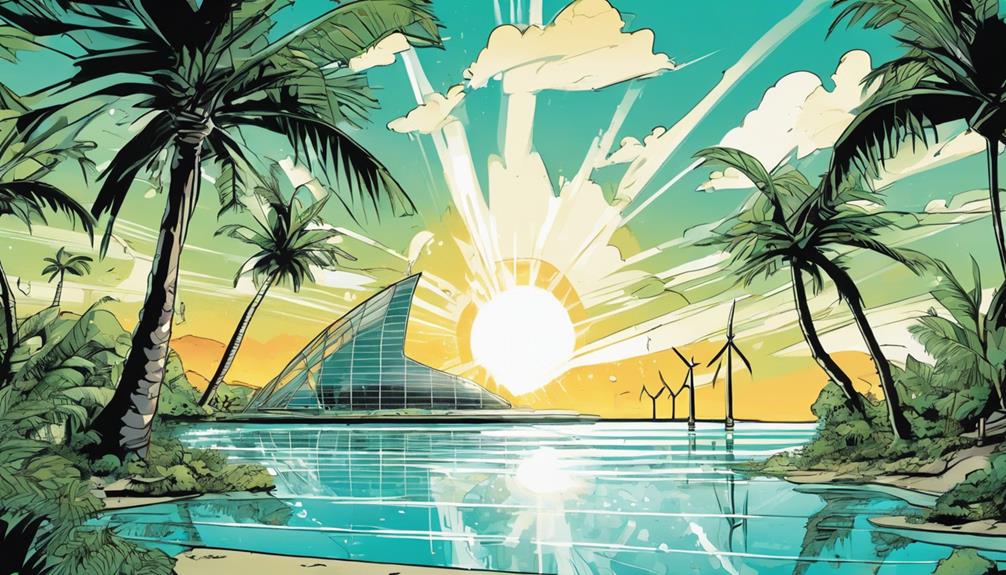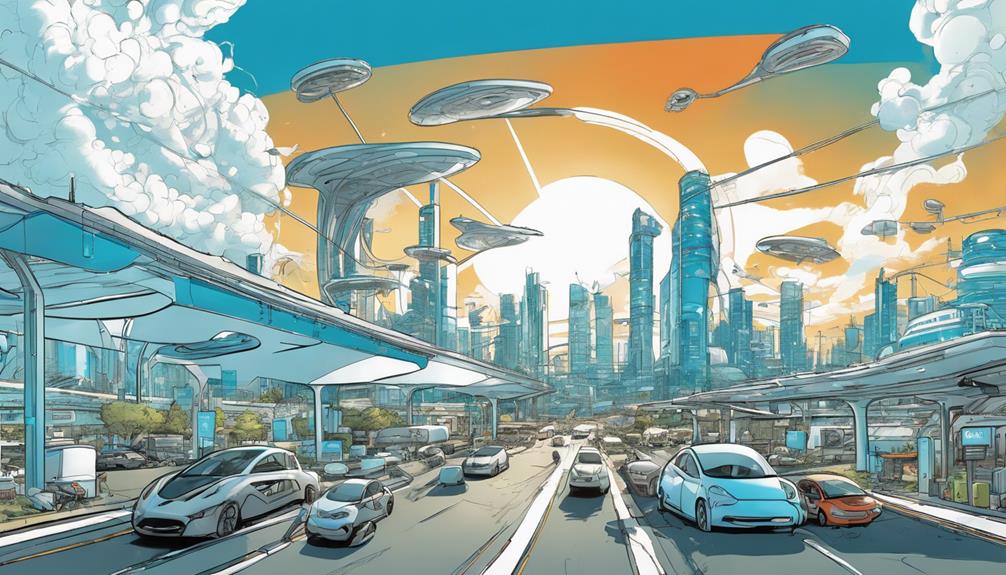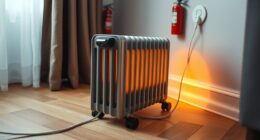Did you know joining wind turbines with solar panels makes a great green power solution? It does! By using both wind and solar energy together, homeowners can get more out of their energy use. They can also cut down on using non-renewable energy. No matter if your area is more windy or sunny, this eco-friendly pair lets you use natural resources fully. This helps make our future cleaner and more sustainable.
Wind turbines and solar panels together give us a more steady energy supply. Wind turbines work even when it’s cloudy or dark, making up for when solar panels can’t work. This way, your energy keeps flowing more evenly, letting you enjoy clean energy anytime. The weather won’t stop you now.
The tech behind wind turbines and solar panels is getting better and more affordable. Blue Pacific Solar has hybrid kits with different powers, like 2 kW or up to 9.3 kW1. These kits can produce a range of energy, from 10,350 Watts to 46,575 Watts, depending on size and wind1. They adapt to both battery and AC systems well1. Blue Pacific Solar supports DIY kits because they save money, are good for the planet, teach valuable skills, and help us not rely on oil and gas1. By picking these DIY kits, you save on installation costs while becoming more self-reliant and eco-friendly1.
Choosing the right combo of wind turbine and solar panel depends on several things. Wind power can be used in both small and large scales, showing it can meet various energy needs2. Solar panels last long with little upkeep, offering a dependable and economical way to make electricity2. Also, there’s work being done on systems to best use wind and solar power depending on the weather, energy demand, and storage2. Using energy storage means these hybrid systems can manage energy better, allowing more renewable energy to be used2. Further improvements in energy storage will make these systems even better in the future2.
In summary, combining wind turbines and solar panels provides an effective and low-impact way to generate energy. It’s a smart choice for those looking for dependable, green energy options. Embracing both wind and sun energy is a step forward to a more eco-friendly future.
Key Takeaways:
- A wind turbine and solar panel combination provides a more reliable and consistent energy supply, even in fluctuating weather conditions.
- Blue Pacific Solar offers a range of hybrid solar wind kits that are cost-effective, empowering, educational, and environmentally friendly.
- Wind power installations and solar panels have the adaptability and longevity to meet diverse energy needs.
- Integration of energy storage technologies optimizes the balance between wind and solar power and enhances grid management.
- Combining wind and solar energy is a commitment to a cleaner and more sustainable future.
The Advantages of Wind and Solar Energy
Wind and solar energy are endless and clean renewable energy sources. They let you enjoy energy independence and cut down on fossil fuel use. This helps create a more sustainable future.
These energies can boost power production in a renewable energy system. A wind-solar hybrid system is the top way to make this system more effective3. Wind turbines and solar panels work together for a steady energy supply. This ensures power is always available, even if one source isn’t3.
Wind and solar can also save money. Building solar farms near wind projects can cut costs by up to 20%4. Wind energy is the cheapest new energy source in the U.S4. By mixing wind and solar, the combined cost can compete with other energy forms. This makes it a good choice for those looking for renewable energy4.
Hybrid systems of wind and solar offer stable electricity all year. Solar panels and wind turbines together ensure electricity is always made5. Using both energy types takes advantage of their strengths and reduces their weaknesses5.
The local weather and climate are vital in creating an effective hybrid system. You need to think about this when making such a system3. Doing research is key before starting a wind and solar hybrid system3.
Combining wind and solar helps manage power generation and storage. Hybrid charge controllers let batteries charge from both energy sources at once3. This balances power output and makes energy use efficient.
To get the most energy from a hybrid system, place solar panels and wind turbines correctly3. Consider sunlight and wind direction for the best results. Having both systems at the same site can double the electricity made, compared to using one system alone, according to4.
Starting with a hybrid setup makes it easy to expand and customize later3. It helps meet increasing energy needs while staying efficient and green3.
Using a hybrid system, extra power can meet specific needs. For instance, DC Water Heating Elements can use this extra power, as noted in3.
In summary, combining wind and solar brings many benefits. These include better performance, cost savings, steady electricity, balanced power, and easy scalability. By using these renewable sources, we can be more independent, use less fossil fuel, and support a greener future.
Blue Pacific Solar: DIY Kits for Renewable Energy
Blue Pacific Solar offers DIY renewable energy kits. They are cost-effective and educational for homeowners. They also empower people to generate their own electricity using the power of wind and solar.
By choosing Blue Pacific Solar, you get complete kits for various levels of expertise. These kits have everything for a wind and solar hybrid system. There are detailed guides and tips to help you set up easily.
Among the main parts of the Blue Pacific Solar DIY kits is a 400W 48VDC Wind Turbine6. It uses wind to make electricity, perfect for your energy system. Plus, you get six 345W solar panels6 with every kit for solar power.
To make wind and solar power work together, a Wind Control Panel and a 6 Position Combiner Box6 are included. These make sure the system runs smoothly and effectively.
Every kit also has a Surge Protector Device to protect against voltage spikes6. To keep it safe, two 15 amp DC Breakers and a 30A Circuit Breaker come with it6.
And for wiring, there’s 50 feet of 10AWG PV Wire6 in every kit. This ensures everything connects well. There are also two 2/0 x 10′ Inverter Battery Cables for your battery system6.
The DIY kits are great for either off-grid or backup power. They can handle a 2 kW 48VDC power system6. This makes them versatile for different energy needs.
Buying a DIY kit from Blue Pacific Solar is easy. Kits are shipped in 5-20 business days, and the Power Center ships in 20-45 days6. The wind turbine’s shipping might change with the seasons6.
Each kit comes with a detailed Three-Line Diagram for installation6. It shows you how to connect everything correctly for the best performance.
When setting up the wind turbine, location matters. It should be 20 to 48 feet above any obstacles6. For efficiency, keep it 480 to 500 feet away from things that might block the wind6.
Blue Pacific Solar helps you pick the right tower for installation6. You can choose from guyed towers, stand-alone towers, or lattice type towers. They guide you to find the best fit for your system6.
For the best energy production, consider winter wind speeds6. Blue Pacific Solar suggests combining wind and solar energy. This mix gives you power all year6.
In some areas, solar power alone is fine6. But in windy places, hybrid systems are better6. These give you a steady and sustainable energy source, no matter the weather.
Pick Blue Pacific Solar for an affordable and smart way to create energy. Building your own system is rewarding. It helps make the future cleaner and teaches you about green technologies. Join the movement with Blue Pacific Solar.
The Cost of Wind-Solar Hybrid Systems
Looking into wind-solar hybrid systems means knowing the costs involved. This includes installing solar panels, wind turbines, and batteries for storage. Don’t forget about the costs for preparing the site, getting permits, and regular maintenance.
Solar panel prices can change based on their type and efficiency. High-efficiency panels cost more but also produce more energy. It’s important to think about the long-term savings these panels can bring.
Wind turbine costs change based on their design and the wind in your area. The blades won’t spin until the wind hits a certain speed, usually between 15 to 50 mph7. And the turbine won’t make electricity until the wind stays strong enough. Also, turbines work best when they are way taller than nearby buildings and placed up to 500 feet away7.
The price of storage batteries depends on their size and technology. Choosing the right battery means it can store extra energy for times when the system makes less electricity or during the night.
Costs also come from getting the site ready and setting up the necessary electrical systems. Local permits can add to your expenses too. It’s crucial to know what your area requires for setting up a wind-solar hybrid system.
The total cost for a hybrid system can be anywhere from $7,000 to $12,0007. There are various models with different powers and prices. For instance, a 2kw system costs $11,216.32 and can produce 4.8-9 kWh daily7. A 5kw system is $14,013.47, making 18-20 kWh each day7. For more power, a 10kw system is $19,616.81 and offers 40-45 kWh daily7.
Wind-solar hybrids have many pluses over just wind or solar. One big wind turbine can make as much power as 48,704 solar panels7. A small 5kWh wind turbine needs about 24 solar panels to equal its energy7. These systems give more power, are more reliable, use less land, save money, and are better for the environment8. They are great for places with less sunlight at certain times8. Also, they can cut down on harmful emissions and help our planet8.
Wind-solar hybrids are a great choice for clean and reliable energy. Seeing the installation cost as an investment means looking forward to savings and environmental benefits. By understanding all the costs, people and companies can choose wisely and help make the earth greener.
Choosing the Right Wind-Solar Hybrid System
Choosing the best wind-solar hybrid system for your home means getting expert advice. Experts look at your area’s sunshine and wind, your property layout, and offer recommendations on where to place solar panels and what size wind turbine you need. They consider turbine size, panel quality, and storage to boost your system’s efficiency9.
Choosing modular pieces for your wind-solar system saves money. They are cheaper by a quarter to a third than combined systems. This way, you can easily replace parts and upgrade without buying a new system. It makes your system flexible for any future energy needs while keeping costs low9.
Optimizing Solar Panel Placement
For windy, snowy places, ground-mounted solar panels work best. They can be turned easily and are protected from hail. Putting screen wire on the panel backs also stops rodents and protects from hail9.
Consider Redundancy for Off-Grid Systems
Having backup parts is key for off-grid systems to keep power on always. Using En Banc for things like panels and batteries ensures reliable power. It gives you confidence and steady energy9.
The Sol-Arc 15k unit handles solar, wind, and generators, powering a whole home. But, it costs around $8,000 USD and may be complex. Being new, it might not be the cheapest or easiest choice9.
The Indian Perspective
In India, wind-solar hybrids help reach a 500 GW renewable energy goal by 2030. The 2018 National Wind-Solar Hybrid Policy supports these systems, leading to 1.44 GW of hybrid capacity. India’s aim for 175 GW of renewable energy by 2022 includes a big role for solar power10.
Looking at wind-solar systems means considering lots of data. Understanding your energy use and learning from others’ experiences help. This approach ensures you pick a system that fits your needs well11.
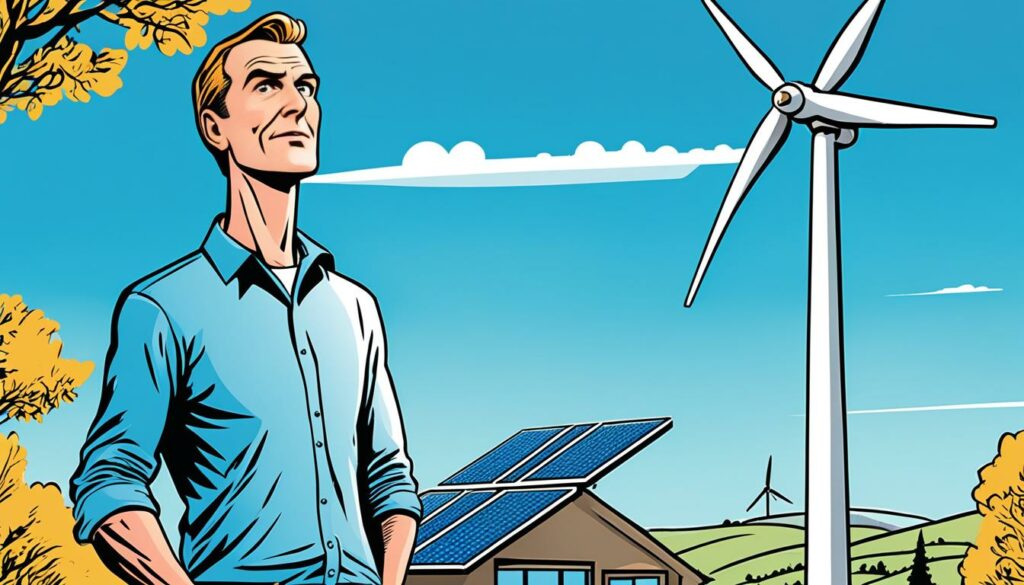
The Pros and Cons of Wind-Solar Hybrid Systems
Wind-solar hybrid systems are a great choice for creating renewable energy. They combine wind turbines and solar panels to boost energy production. This mix allows for electricity generation in different weather, ensuring a steady power supply12.
These systems also lead to less reliance on the grid. They produce their own electricity, helping users to be more independent and eco-friendly. This lowers the impact of rising energy prices and supports a sustainable future12.
Compared to traditional energy sources, wind-solar hybrids leave a smaller mark on the environment. Using renewable sources, they reduce harmful emissions and fight against climate change. This supports the push towards a world that values sustainability and cleaner energy solutions13.
The benefits of wind-solar systems are clear, but they have their downsides too. The initial setup costs can be high because of the equipment needed. Yet, the price of these systems has been dropping, making them more affordable14.
Keeping these systems running involves some costs too. Wind turbines last longer but need regular checks and cleaning to work well. Things like inspections and repairs can’t be overlooked14.
Noise can be a concern with wind turbines. Even though they’re not very loud, they might be noticeable in quiet areas. It’s important to think about where they’re placed and follow noise rules14.
There’s also the issue of needing enough space. Wind turbines and solar panels take up room, which might not work for everyone. Technology is helping to make better use of available space, though14.
Wind-solar hybrid systems have a lot to offer, like more energy, less grid reliance, and being better for the planet. However, we can’t ignore the setup costs, maintenance needs, noise, and space requirements. Looking at both sides helps in picking the best renewable energy option141213.
Maximizing Energy Output with Wind and Solar Integration
Optimizing Energy Output for a Sustainable Future
Wind and solar technologies together provide a mighty solution for better energy use. They unleash the full potential of renewable resources. This leads to a sustainable future.

The Role of Smart Controllers in Energy Management
Smart controllers are vital in boosting energy output in wind and solar systems. They manage the flow of electricity for efficient use. They ensure power is well-distributed, stored, and used.
Thanks to smart algorithms, these controllers fine-tune power generation. They help the system perform better and adjust to changing weather.
Unlocking the Potential of Battery Technologies
Battery tech plays a big role in maximizing wind and solar energy output. Batteries store extra energy for times when there’s less wind or sun. This means a steady power supply always.
Improved battery tech makes green energy systems more efficient and reliable.
Advantages of Smart Grid Solutions
Smart grids make the most out of wind and solar energy integration. They offer real-time tracking and managing of energy flow. This smooths out the addition of green power into our current grid.
By matching energy supply with demand and supporting energy sharing, smart grids boost network stability and efficiency. They help move us away from fossil fuels.
Unlocking the Potential of Wind and Solar Integration
Wind and solar energy together bring many benefits. Wind power is great for big spaces and has lower costs. Solar power fits small spaces and rooftops well.
This combination gives us more electricity, less pollution, and saves money. It’s a win-win for the planet and our pockets.
Success Stories with Wind-Solar Hybrid Systems
Check out inspiring stories of people and companies choosing wind-solar hybrid systems for green energy. They’ve cut energy costs and helped the planet. Automaxx’s hybrids offer dependable, efficient power for a brighter, greener future.
In western Minnesota, a hybrid system with solar and wind power saves $150,000 annually. It cost $5 million and mixes 500 kW of solar with a 2 MW wind turbine. This shows the financial perks of combining wind and solar.
Wind energy could supply the U.S. with 1,400 gigawatts of clean power. Placing wind and solar systems together cuts costs by 20%. Hybrid setups not only lower upfront costs by 2.5% but also double the power in the same space. They can even earn money through net metering by giving extra power back to the grid.
Automaxx’s hybrids blend small wind turbines and solar panels for more power and less environmental harm. These systems use advanced design and tech to save space. Smart tech manages energy for better distribution, storage, and use. High-tech batteries store surplus energy for consistent supply.
In India, mixing wind and solar power lowers electricity costs more than using them alone. With plenty of sunshine, India prefers solar at 63% of sites. In Texas, hybrids reliably cover 75% of electricity needs. They can also save 30% annually compared to separate systems. This highlights the global advantage of wind and solar hybrids. p>
Success stories worldwide prove the benefits of wind-solar hybrids. Users enjoy lower bills and support a sustainable future.
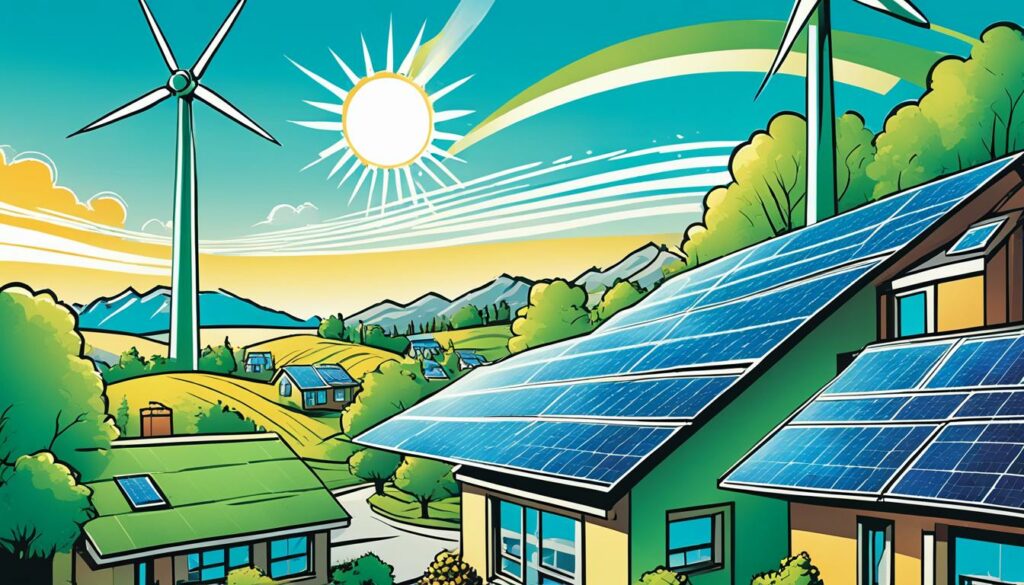
| Statistical Data | Reference Number |
|---|---|
| Colocating wind and solar plants can reduce infrastructure costs by 20%, presenting a cost-effective renewable energy solution. | 18 |
| Hybrid wind-solar power generation can offer up to twice the electricity output within the same area compared to standalone systems. | 18 |
| Grid-tied hybrid systems with net metering can provide monetary incentives by supplying excess power back to the community grid. | 18 |
| Hybrid systems can save on initial project costs by up to 2.5%. | 18 |
| In western Minnesota, a $5 million investment created a hybrid system combining 500 kW solar power with a 2 MW wind turbine, cutting costs by $150,000 a year. | 18 |
| In the US, wind energy has the potential to power nearly 1,400 gigawatts of clean power. | 18 |
| Over 50 MW-scale projects in hybrid systems are in progress globally. | 18 |
| Solar panels are projected to reach cost levels as low as 2 INR/kWh. | 18 |
| Wind turbines are undergoing advancements for longer lifespan and enhanced designs. | 18 |
| Energy storage costs are projected to fall below $100/kWh. | 18 |
| Components for a 6kW system in India: Wind Aero Generator costs between ₹2,21,800 – ₹5,92,000 per kW, Solar Photovoltaic Panels range from ₹74 – ₹111 per watt, and Lithium-ion batteries cost ₹20,900 per kWh, with a total average cost of ₹9,33,450 post incentives. | 18 |
| Increased energy yield from hybrid wind-solar systems compared to single-source systems. | 19 |
| Reduction in grid dependency due to the integration of wind and solar technologies. | 19 |
| Advantages include improved energy production, decreased environmental impact, and enhanced energy efficiency. | 19 |
| Challenges include intermittency issues that require innovative technologies to address. | 19 |
| Advancements in design and technology have made hybrid systems more space-efficient. | 19 |
| Smart controllers enhance energy management and optimize energy distribution, storage, and consumption. | 19 |
| Advanced battery technologies are utilized to store excess energy for use during periods of low wind or sunlight. | 19 |
| Automaxx offers leading hybrid solutions that seamlessly integrate small wind turbines with solar panels. | 19 |
| Real-world success stories demonstrate reduced energy bills and environmental benefits from embracing hybrid wind-solar systems. | 19 |
| India set a goal to achieve 500 GW of renewable energy capacity by 2030. | 20 |
| The combination of 49 GW of wind and 32 GW of solar capacity in India shows lower electricity costs when used together compared to standalone. | 20 |
| Around 63% of sites in India favored solar energy due to the country’s strong sunlight. | 20 |
| Hybrid systems in Texas can provide up to 75% of required electricity constantly. | 20 |
| Hybrid systems in Texas can cut 30% off electricity costs yearly compared to standalone systems. | 20 |
| More than 174 GW of installed renewable energy capacity was reported in India by 2023. | 20 |
| The cost of solar power has decreased by 84% and wind power by 49% in India since 2010. | 20 |
| India attracted INR 20.5 billion in Foreign Direct Investment (FDI) in the renewable sector in Q3 of the financial year 2023. | 20 |
| India projects a renewable energy capacity of 280 GW by 2025. | 20 |
Conclusion
Combining wind turbines with solar panels gives homeowners and businesses a green power solution. This option supports renewable energy and makes energy independence possible. It’s a great choice for those looking to lower their carbon footprint and live more eco-friendly.
This hybrid system is great because it offers a steady supply of energy21.Wind and solar power together mean fewer energy drops caused by the weather21. This system can be customized to fit specific needs, which boosts energy production and efficiency21.
Though wind-solar systems have upfront costs, the benefits are worth it in the long run. The typical cost for setting up solar panels at home in the U.S. is about $13,00022. Wind turbines might lead to the deaths of 140,000 to 500,000 birds annually22. Yet, using both solar and wind energy greatly reduces emissions, helping fight climate change and supporting sustainability2223. As clean energy grows, old methods like coal are fading away22.
The combination of wind turbines and solar panels is a long-lasting power solution23.It offers energy freedom, cuts down carbon emissions, and brings forth clean, dependable, and affordable energy. By using both wind and solar power, we can positively impact the environment. This approach secures resources for future generations, benefiting everyone, now and later23. Choosing this combination isn’t just a trend; it’s a significant move in transforming how we create, share, and use power, leading to a greener future23.
